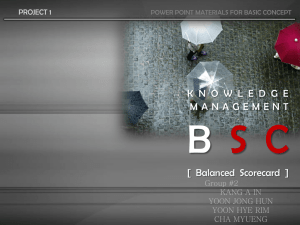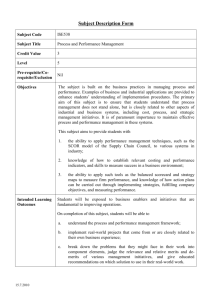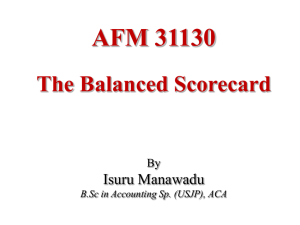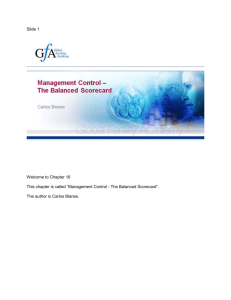Abstract-Papers up to 4 pages should be submitted
advertisement
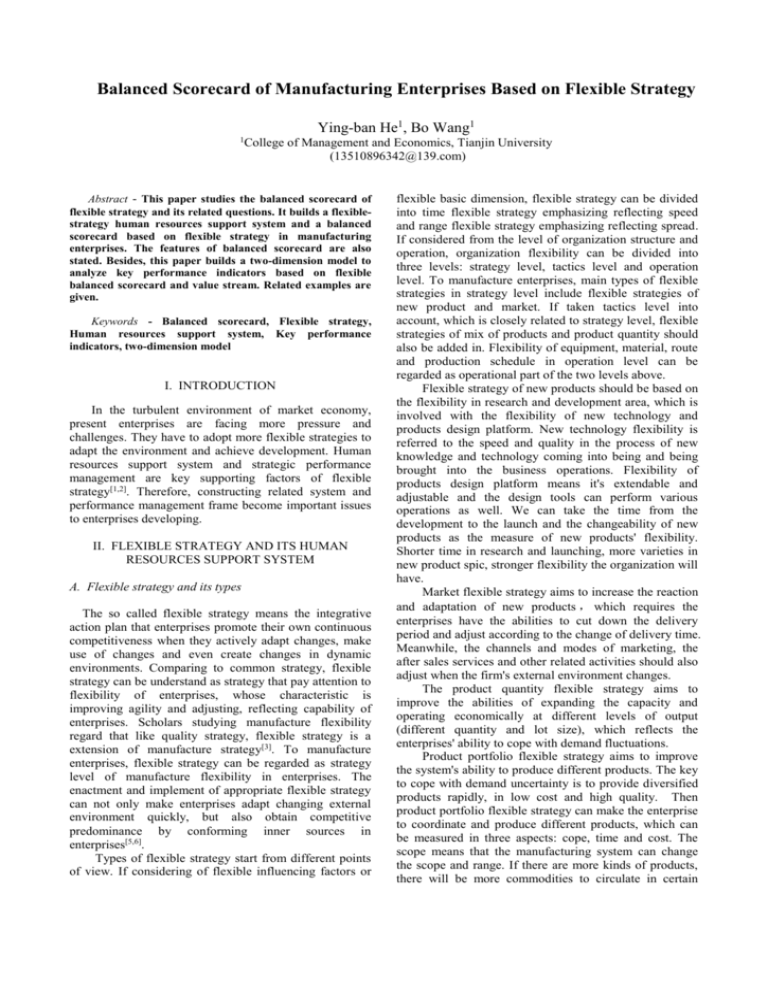
Balanced Scorecard of Manufacturing Enterprises Based on Flexible Strategy Ying-ban He1, Bo Wang1 1 College of Management and Economics, Tianjin University (13510896342@139.com) Abstract - This paper studies the balanced scorecard of flexible strategy and its related questions. It builds a flexiblestrategy human resources support system and a balanced scorecard based on flexible strategy in manufacturing enterprises. The features of balanced scorecard are also stated. Besides, this paper builds a two-dimension model to analyze key performance indicators based on flexible balanced scorecard and value stream. Related examples are given. Keywords - Balanced scorecard, Flexible strategy, Human resources support system, Key performance indicators, two-dimension model I. INTRODUCTION In the turbulent environment of market economy, present enterprises are facing more pressure and challenges. They have to adopt more flexible strategies to adapt the environment and achieve development. Human resources support system and strategic performance management are key supporting factors of flexible strategy[1,2]. Therefore, constructing related system and performance management frame become important issues to enterprises developing. II. FLEXIBLE STRATEGY AND ITS HUMAN RESOURCES SUPPORT SYSTEM A. Flexible strategy and its types The so called flexible strategy means the integrative action plan that enterprises promote their own continuous competitiveness when they actively adapt changes, make use of changes and even create changes in dynamic environments. Comparing to common strategy, flexible strategy can be understand as strategy that pay attention to flexibility of enterprises, whose characteristic is improving agility and adjusting, reflecting capability of enterprises. Scholars studying manufacture flexibility regard that like quality strategy, flexible strategy is a extension of manufacture strategy[3]. To manufacture enterprises, flexible strategy can be regarded as strategy level of manufacture flexibility in enterprises. The enactment and implement of appropriate flexible strategy can not only make enterprises adapt changing external environment quickly, but also obtain competitive predominance by conforming inner sources in enterprises[5,6]. Types of flexible strategy start from different points of view. If considering of flexible influencing factors or flexible basic dimension, flexible strategy can be divided into time flexible strategy emphasizing reflecting speed and range flexible strategy emphasizing reflecting spread. If considered from the level of organization structure and operation, organization flexibility can be divided into three levels: strategy level, tactics level and operation level. To manufacture enterprises, main types of flexible strategies in strategy level include flexible strategies of new product and market. If taken tactics level into account, which is closely related to strategy level, flexible strategies of mix of products and product quantity should also be added in. Flexibility of equipment, material, route and production schedule in operation level can be regarded as operational part of the two levels above. Flexible strategy of new products should be based on the flexibility in research and development area, which is involved with the flexibility of new technology and products design platform. New technology flexibility is referred to the speed and quality in the process of new knowledge and technology coming into being and being brought into the business operations. Flexibility of products design platform means it's extendable and adjustable and the design tools can perform various operations as well. We can take the time from the development to the launch and the changeability of new products as the measure of new products' flexibility. Shorter time in research and launching, more varieties in new product spic, stronger flexibility the organization will have. Market flexible strategy aims to increase the reaction and adaptation of new products , which requires the enterprises have the abilities to cut down the delivery period and adjust according to the change of delivery time. Meanwhile, the channels and modes of marketing, the after sales services and other related activities should also adjust when the firm's external environment changes. The product quantity flexible strategy aims to improve the abilities of expanding the capacity and operating economically at different levels of output (different quantity and lot size), which reflects the enterprises' ability to cope with demand fluctuations. Product portfolio flexible strategy aims to improve the system's ability to produce different products. The key to cope with demand uncertainty is to provide diversified products rapidly, in low cost and high quality. Then product portfolio flexible strategy can make the enterprise to coordinate and produce different products, which can be measured in three aspects: cope, time and cost. The scope means that the manufacturing system can change the scope and range. If there are more kinds of products, there will be more commodities to circulate in certain period, and the flexibility will be higher. The shorter the time took to change the product variety, and the lower of the cost taken place, the higher of the flexibility. As the accelerating changes of the competitive environment, flexible strategy has been widely recognized and valued[7,8]. There are more and more research on the analysis and formulation of flexible strategy. However, any success does not consist in strategy formulation, but also on effective implementation. Flexible strategy is no exception. There is scarce research on the implementation of flexible strategy before, especially the study on how to implement it by performance management and other strategy implementation means. Meanwhile, there are few researches on the combination of performance management and flexible strategy. So it's necessary to have in-depth study of the flexible strategy oriented performance management. B. The human resources support system of flexible strategy Based on system theory, the system target of human resources support system matching to flexible strategy is effectively supporting the implementation of flexible strategy. The output of system is the human resources strategy and the input of system is the human resources effectively supporting flexible strategy of organization. The environment of system includes inner environment factors and outside macro environment factors. System structure is mainly constituted by procedure system and support system of human resources support system. Human resources support system is established mainly based on the related management functions in the whole life cycle of human resources management. Besides the human resources planning, the input of the system mainly consist of reasonable position, responsible match between the personnel selection and configuration, accurate assessment of individual ability and achievement, various forms of training aimed to different levels of employees, and incentive mechanisms corresponding to different assessment results. Human resources support system includes institution security system and dynamic adjustment system, whose whole conceptual model is as Fig. 1. System target Supporting flexible strategy effectively System function: human resource function and other management support systems matching to flexible strategy System input Human resource strategy Position setting Staff allocating Performance management Incentive Mechanism Position setting matching to flexible strategy Staff allocating matching to flexible strategy Performance management matching to flexible strategy Incentive Mechanism matching to flexible strategy Staff training Systematical procedure system personnel recruitment personnel staffing System input Effective supporting strategy Supporting procedures Institution guarantee system Dynamic adjustment system Systematical support system System structure System circumstance Inner circumstance factors: requests of strategy planning and flexible strategy to tactics level, operation level, culture and other management support system etc. Outside circumstances factors: market circumstances, political and legal circumstances, related policy changing of government, situation of labor market, situation of industry developing Fig. 1. Conceptual model of human resources support system based on flexible strategy III. THE BALANCED SCORECARD BASED ON FLEXIBLE STARTEGY The core component of human-resource support system is the performance management of flexible strategy [9-11]. In recent years, the Balanced Scorecard (BSC) has been widely acknowledged as an effective way of strategic performance management. This management method, raised by Kaplan and Norton in the early 1990s, is based on researches on some famous enterprises which are outstanding in this field. Not only does this method emphasize on measuring performance, but also taking into account long-term and short-term effects, financial and non-financial aspects, internal and external areas as well as motivation and results[12,13]. It also plays a crucial role in the classification of strategic themes of four interrelated levels - the financial level, the customer level, the internal operating level and the learning and development level. The performance management of flexible strategies refers to a management method which is oriented by flexible strategies and also supportive of it. BSC based on Flexible Strategy is in common with common Balanced Scorecard in following aspects— they are both powerful tools of strategy implementation and crucial frameworks of strategy classification. Also, their premises are both established strategies while the premise of BSC of flexible strategies is flexible strategies. On the contrary, the differences between BSC based on Flexible Strategy and common Balanced Scorecard are as follows—BSC based on Flexible Strategy regards the implementation of flexible strategies and interests of customers and shareholders as its premise, the ensurement of flexible support is the major target of its internal processes and development dimensions. Also, BSC based on Flexible Strategy ranges over a certain degree of flexibility in index decomposition and index value’s credibility in four dimensions. This paper presents an example of BSC of flexible strategies in manufacturing industry, as shown in Fig. 2. Financial view How to implement flexible strategy to explode financial benefit on shareholders’ behalf Customer view How to launch new flexible products and sustain the market flexibility from the point of customer’s view? Inner procedure view Flexible strategy: new product and market flexibility What procedures should be excellent for keeping the flexibility of new products and market Learning and developing view How to keep continuous developing in flexible capability of enterprises Fig. 2. The Balanced Scorecard of flexible strategy in manufacture enterprises BSC of flexible strategy based on enterprises can be used to establish performance objectives of the department. The flexible expression for different administrative departments, aiming at ensuring the strategic flexibility of the whole enterprise, serves as support of various branches’ functions. It can be measured by requirements and classification index of BSC of flexible strategy. For example, flexible embodiment of Department of Production Management mainly aims at ensuring flexibility of new products and market. Flexible embodiment serves as a necessary flexible production process and the ability to adapt to rapid changes. Targets of post-performance based on flexible strategies are the classification of department’s flexible performance targets. As for the setting of postperformance targets, not only should we consider post’s environment and duty, but also take internal and external customers’ needs and expectations into account. Flexible strategy-oriented performance management requires the establishment of an effective mechanism to allow rapid adjustment and modification of the post’s duty and privilege with the change of enterprise strategy. We should also take into account inter-departmental processes and internal and external customers’ requirement to suppliers in order to relate the post target with corporate strategic objectives. IV. KEY PERFORMANCE INDICATORS BASED ON FLEXIBLE BALANCED SCORECARD A key performance indicator (KPI) plays a crucial role in the establishment of performance management target process based on BSC [14] [15]. KPI, based on BSC, is the measurement of controlled parts in key business activities. KPI based on flexible strategies is in common with common KPI in following aspects—they are both powerful tools of strategic performance management as well as the main carrier of BSC’s classification and realization. Both of their premises are developed strategies and BSC based on strategy, while KPI based on flexible strategy’s premise is flexible strategy and BSC based on flexible strategy. Therefore, compared with common KPI, the selection of KPI based on flexible strategy’s targets sets the ensurement of flexible support for enterprises as its basis. Meanwhile, it has a certain degree of flexibility in classification of BSC’s index value (either basic value or challenge value) in four dimensions. The establishment of classification framework for KPI based on BSC is a crucial section for performance management based on flexible strategy. In particular, it is important for the departmental key performance indicator system for the reason that post KPI is based on that of its department. The paper, setting manufacturing enterprises as background, proposes a KPI classification model based on BSC and value process (as shown in Fig. 3). Key Performance targets based on flexible strategies Flexible Strategy KPI of each sector and position in financial perspective based on flexible BSC Finance perspective KPI of each sector and position in customer perspective based on flexible BSC Customer perspective KPI of each sector and position in internal process perspective based on flexible BSC Internal Process perspective Learning and development perspective KPI of each sector and position in learning and development perspective based on flexible BSC R&D and design Supplying & Purchasing Manufacturing …… Marketing Fig. 3. The two-dimension model of the decomposition of KPI based on flexible balanced scorecard The longitudinal axis of the model is composed of four dimensions of BSC. It is the KPI of the corporate level and can be extended to the strategy map of BSC. The horizontal axis of the model is the value process of the enterprise. Each process always corresponds to the enterprise’s sectors (not necessarily one-to-one correspondence). It is a KPI framework of BSC. The specific operation should first be the establishment of BSC of flexible strategy, and then the classification of various dimensions, namely the KPI on the corporate level or the strategy map. We should also make clear the functions and divisions of labor in each process (or department). Then we can proceed with departmental KPI design based on the two-dimensional crossover. Constructed of the four dimensions of the balanced scorecard, the vertical axis of the model, as the key performance indicators at the company level, can be expanded to be a strategy map based on the balanced scorecard. The horizon axis is the value stream of the company, with each process corresponding to some specific departments (not necessarily to be one-to-one). This is a framework of building key performance indicators of each department based on the balanced scorecard. In specific operations, with the decomposition of all dimensions, a balanced scorecard based on the flexible strategy, namely a map of key performance indicators or a strategy map at the company level, should be made firstly, while each process (department) clearly knows its functions and divisions. Thus the design of key performance indicators of each department based on this two-dimensional crossover can be carried out. V. EXAMPLES CW Mold Company is a full funded branch of the huge CW Group operating home appliances, owning total assets of more than 50 million Hong Kong dollars. With a high starting point, high technology and high investments, the company engages in research and development, precision manufacturing and technical services at a suit, providing the design and manufacture of kinds of molds from small precisions molds like mobile phone shells and micro-motors at most to large injection molds such as TV shells, auto parts and molds weighing up to 50 tons. While based upon domestic market, the company positively participates in the international market competition. The flexible strategy of CW Group is dominated by flexibility of new products and supplemented with market flexibility. As a subsidiary branch of CW Group, CW Mold Company’s flexible strategy shall comply with CW Group and be strategy at operation and strategy level supporting the group strategy under the guidance of it. As the main purpose of the flexible strategy of new products is to increase the ability of increasing new products, that is the ability of manufacturing system to launch new products timely and modifying the functions and appearance of the existing product available on the market to satisfy customer demands rapidly by introducing and fabricating new parts and products. While the purpose of the flexible strategy is to enhance the ability of the enterprise to adapt to or to influent the market, the enterprise should have the ability of shortening the delivery time and adjusting to correspond to the delivery change request, and at the meantime have the strain capacity of marketing channels, marketing mode, customer service and the marketing related activities under the external environment changes. Therefore, the product flexibility of the CW mold company should be built to ensure the flexibility of the manufacturing system, which includes a flexible mold and manufacturing system, as well as the flexible production plan, so as to ensure mix flexibility and volume flexibility of the mold products. The balanced scorecard and key performance indicators based on the flexible strategy at the company level is shown in Fig. 4. Financial performance Customer market Key Performance Indicators Average profit per person and its growth rate New flexible products sales and its growth rate Market share Market increase rate of new flexible products Quality level of the products Internal operation Rapid response capability Study and training rate Employee satisfaction Ability of Flexibility innovation Learning and development Fig.4 Key Performance indicators of Flexible Strategy in CW Molding Company The main processes of the company consist of research and development design, supply purchase, production quality inspection, marketing and after-sales service. With the two-dimension model, BSC and key performance indicators at the company level can be decomposed to each department. The framework of the decomposition and the example are shown in Table 1. TABEL I DECOMPOSITOIN FRAMEWORK OF DEPARTMENT’S KEY PERFORMANCE INDICATORS AND EXAMPLE Design of new Production of Quality of new Sales of new Supply of new After sales of new flexible new flexible flexible flexible finance flexible production flexible production production and production and production and production and perspective and costs... and costs… costs… costs… costs… costs… Customer Customer satisfaction satisfaction of the of the after-sales Customer design of the new Market share… Market share… Market share… Market share… services of the new perspective flexible production flexible production Market share… market share… Process perspective Learning and development perspective Capability of rapid design of new flexible production… Supply capability of Components and parts of new flexible production… Productivity of new flexible production … Quality assurance capacity of new flexible production… Quality assurance capacity of new flexible production… Quality assurance capacity of new flexible production… Employee satisfaction… Employee satisfaction… Employee satisfaction… Employee satisfaction… Employee satisfaction… Employee satisfaction… Design Department Purchasing Department Production Department Quality Control Department On this basis, decomposition of key performance indicators of positions will form an index system of flexible performance management. After index systems being built from top to bottom, and a performance management process being constructed by performance planning, performance guidance, performance evaluation and performance rewards, the whole performance management system will be accomplished, which will be an effective support of flexible strategy. REFERENCES [1] Chavan, M. The Balanced Scorecard: A New Challenge. Journal of Management Development, 2009, 28(5), 393-406. [2]Bonfim, W. S., E. P. De Lima and S. E. G. Da Costa. Process - an Approach to Strategic and Operational Integration. Journal of Integrated Design and Process Science, 2004,8(3), 37-47. [3] Robert S. Kaplan, David P. Norton. The Balanced Scorecard— Translating Strategy Into Action. Guang Dong Econonic Press, 2004. [4]Aldrich. Organizations and environments. California: Stanford Business Books, 2007, 1-349. [5]Li, Y. and H. Wang. A New Enterprise Value Chain Evaluation Method. 2010, Wuhan, 514-17. [6]Crandall, R. E. Keys to Better Performance Measurement. IEEE Engineering Management Review, 2002, 30(3), 58-63. [7]Zhang, T. Study on the Performance Management System of ServiceOriented Manufacturing Enterprises, 2011, Harbin: 235-39. Sales Department After-sales Services Department [8]Guimarães, B., P. Simões and R. C. Marques. Does Performance Evaluation Help Public Managers? A Balanced Scorecard Approach in Urban Waste Services. Journal of Environmental Management, 91(12), 2632-38.. [9]Flores, M., A. Al-Ashaab and A. Magyar. A Balanced Scorecard for Open Innovation: Measuring the Impact of Industry-University Collaboration, L. M. Camarinha-Matos, I. Paraskakis and H. Afsarmanesh, 2009, 23-32 [10]Kelly, S. P. and R. Ravenscroft. 2007. Natural Resources Perspective of the Balanced Scorecard: Balance and Boundaries. Rangelands, 2010, 29(2), 13-17. [11]Farrokhi, M., M. A. Aftabi and M. Hemati. Evaluation and Weighting Balanced Scorecard Critical Factors by Means of Fuzzy Analytic Hierarchy Process (a Case Study). World Applied Sciences Journal, 2012, 16(2), 300-12. [12]Li, B. and Y. Wang. 2010. Study on the Enterprise Strategic Budget Management Mode Based on Balance Scored Card, Guangzhou: 2798801. [13]Kongar, E. Performance Measurement for Supply Chain Management and Evaluation Criteria Determination for Reverse Supply Chain Management. S. M. Gupta, Philadelphia, 2004, PA: 106-17. [14]Liu, G., K. Yu, C. Wang and P. Yu. A Study of Enterprise Performance Management System Based on Kpi +Bsc, 2010, Kunming: 468-72. [15]Northcott, D. and T. M. Taulapapa. Using the Balanced Scorecard to Manage Performance in Public Sector Organizations: Issues and Challenges. International Journal of Public Sector Management, 2012, 25(3), 166-91.

